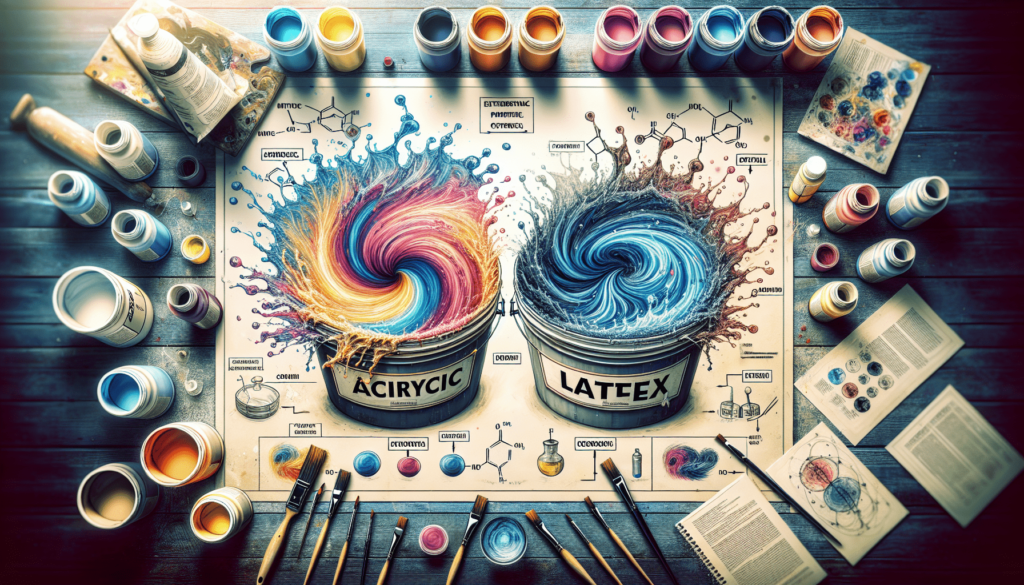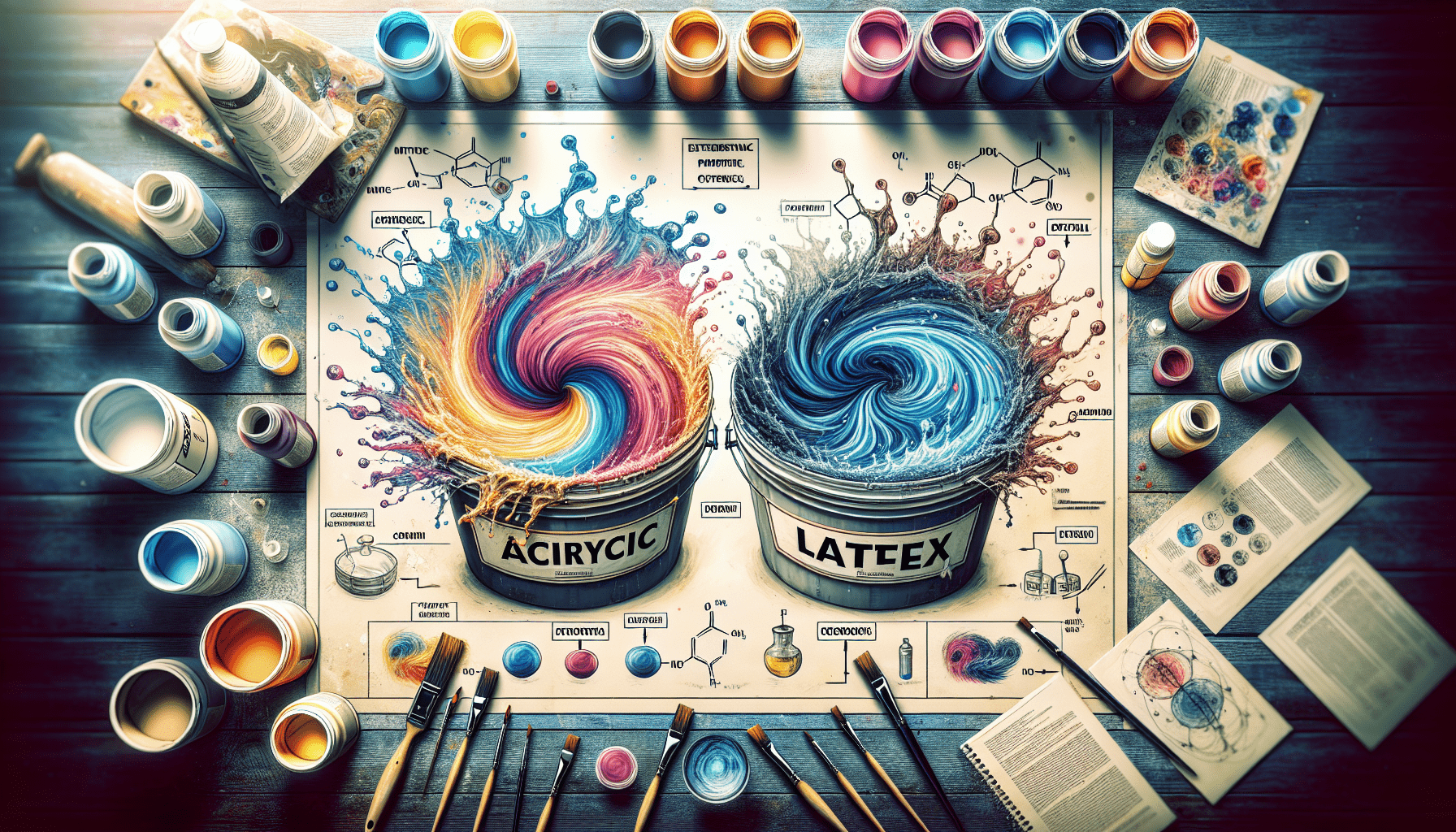When it comes to mixing different types of paint, such as acrylic and latex, you may find yourself wondering if it is a feasible option. The compatibility of these two paints is a common concern for artists and homeowners alike. In this article, we will explore the possibility of mixing acrylic paint with latex paint, highlighting any potential benefits or drawbacks that may arise from such a combination. By the end, you will have a clear understanding of whether it is possible to achieve your desired results through this paint mixing endeavor.
Understanding Acrylic Paint and Latex Paint
What is acrylic paint?
Acrylic paint is a versatile and widely-used type of paint that is known for its fast-drying and water-soluble properties. This paint is made from a pigment suspended in an acrylic polymer emulsion, making it durable and long-lasting. Acrylic paint can be used on various surfaces such as canvas, wood, paper, and more.
What is latex paint?
Latex paint, also known as water-based paint, is a type of paint that contains a water-soluble base. It is commonly used for interior and exterior house painting and can be applied to surfaces like walls, ceilings, and trim. Latex paint is known for its easy cleanup with soap and water and for being low in volatile organic compounds (VOCs).
Differences Between Acrylic Paint and Latex Paint
Composition
Acrylic paint is composed of a pigment suspended in an acrylic polymer emulsion, which gives it its structure. On the other hand, latex paint consists of a pigment suspended in a water-based emulsion containing synthetic resins and polymers. The difference in composition affects the behavior and performance of each type of paint.
Drying Time
One significant difference between acrylic paint and latex paint is their drying time. Acrylic paint dries quickly, usually within hours, allowing for multiple layers and faster completion of artwork or projects. On the contrary, latex paint has a longer drying time, with some formulations taking up to a day or more to fully dry.
Durability
Acrylic paint is known for its exceptional durability and longevity. Once it dries, it forms a hard and flexible surface that resists cracking, fading, and yellowing over time. Latex paint, although durable, may not have the same level of resistance as acrylic paint. It is more commonly used for interior applications where it is less exposed to harsh weather conditions.
Finish
The finish of acrylic paint and latex paint can also differ. Acrylic paint can have a range of finishes, including matte, satin, glossy, or even iridescent. This versatility allows artists and painters to achieve their desired aesthetic. Latex paint, on the other hand, is typically available in a flat or eggshell finish, which is more suitable for interior walls.
Versatility
Acrylic paint offers a wide range of applications, making it a popular choice for artists, hobbyists, and professionals alike. It can be used on canvas, wood, paper, fabric, and various other surfaces. On the contrary, latex paint is primarily used for house painting and may not be as versatile for artistic or craft projects.

Can You Mix Acrylic Paint with Latex Paint?
Compatibility
Mixing acrylic paint with latex paint is possible, but it is important to consider the compatibility of the two types of paints. Acrylic paint and latex paint have different chemical compositions, and therefore, they may not always mix well together. It is crucial to conduct a compatibility test before mixing larger amounts of the paints.
Effects of Mixing
Mixing acrylic paint with latex paint can result in a combination of their respective characteristics. The drying time may be influenced by the slower-drying latex paint, while the durability can be enhanced by the acrylic paint. The overall finish and appearance may also be affected, depending on the ratio and technique used for mixing.
Potential Issues or Drawbacks
While mixing acrylic paint with latex paint can offer unique effects and properties, there are potential issues or drawbacks to consider. The different drying times may result in uneven drying, leading to problems like cracking or peeling. Additionally, the compatibility of the two paints may vary depending on the specific brands and formulations used.
Benefits of Mixing Acrylic Paint and Latex Paint
Color Customization
One significant benefit of mixing acrylic paint and latex paint is the ability to customize colors. By combining different pigments from both types of paint, you can create unique shades and hues that may not be readily available in pre-mixed paints. This allows for more personalized and custom color options.
Consistency Adjustment
Mixing acrylic paint with latex paint can also provide the opportunity to adjust the consistency of the paint. Acrylic paint is known for its thicker and more viscous texture, while latex paint can be relatively thinner. Combining the two paints can result in a consistency that is easier to work with or more suitable for specific applications.
Versatile Applications
By mixing acrylic paint and latex paint, you can expand the range of applications for your paint. The durability and fast-drying properties of acrylic paint can complement the easy cleanup and versatility of latex paint. This combination opens up possibilities for various projects, from furniture refinishing to wall art and craft projects.

Tips for Mixing Acrylic Paint with Latex Paint
Use Proper Ratios
When mixing acrylic paint with latex paint, it is important to use proper ratios to achieve the desired effects. Start by adding small amounts of acrylic paint to the latex paint and gradually increase the ratio until you reach the desired color and consistency. Experimentation and testing are crucial in finding the right balance.
Test the Mixture
Before applying the mixed paint to your desired surface, it is recommended to test the mixture on a small, inconspicuous area. This allows you to assess the compatibility, drying time, and overall appearance of the paint. It is better to make adjustments and modifications on a small test area before committing to a larger project.
Mixing Techniques
Different mixing techniques can yield different results when combining acrylic paint and latex paint. Stirring the paints gently can help achieve a more uniform mixture, while vigorous mixing or shaking may introduce air bubbles. Experiment with different methods and find the technique that works best for your specific project or artistic style.
Clean Tools and Brushes
After mixing acrylic paint and latex paint, it is important to clean your tools and brushes thoroughly. Use warm water and mild soap to remove any paint residues. Properly cleaning your tools ensures the longevity and effectiveness of your painting tools and prevents any unwanted mixing or contamination when using them for future projects.
Specific Applications for Mixed Acrylic and Latex Paint
Furniture Refinishing
The combination of acrylic paint and latex paint can be particularly useful for furniture refinishing projects. The durability of acrylic paint can enhance the longevity of the furniture’s finish, while the water-based properties of latex paint make it easier to clean and maintain. This combination allows for creative finishes and customization of furniture pieces.
Wall Art
Mixing acrylic paint with latex paint can also be beneficial for creating wall art. The versatility of acrylic paint allows for various textures, effects, and finishes, while the easy cleanup and low VOCs of latex paint make it suitable for indoor applications. This combination can result in unique and visually striking wall art pieces.
Craft Projects
Craft projects can also benefit from the mix of acrylic paint and latex paint. The ability to customize colors and adjust consistency can be valuable when working on crafts such as wooden signs, decorative items, or DIY home projects. The combination of durability and versatility in these paints opens up a wider range of possibilities for craft enthusiasts.
Precautions When Mixing Acrylic Paint with Latex Paint
Avoid Mixing in Large Amounts
It is generally advised to avoid mixing acrylic paint and latex paint in large amounts, especially if you are unsure of their compatibility. Mixing small quantities allows for better control and minimizes the risk of wasting larger quantities of paint in case the mixture does not yield the desired results.
Consult Product Labels
Before mixing any paints, it is essential to consult the product labels of both the acrylic paint and latex paint. These labels provide important information on the paint’s composition, compatibility, and any specific instructions or warnings related to mixing with other paints. Following the guidelines provided by the manufacturers ensures a better outcome.
Consider Environmental Factors
When mixing acrylic paint with latex paint, it is crucial to consider the environmental factors that may affect the drying time and overall performance of the paint. Temperature, humidity, and airflow can all impact the drying process. It is advisable to work in a well-ventilated area and take necessary precautions to ensure optimal conditions for the paint to dry and cure.
Conclusion
Understanding the differences between acrylic paint and latex paint is crucial when considering mixing the two for various projects. While mixing acrylic paint with latex paint can offer benefits like customizable colors and adjusted consistency, it is important to consider compatibility, potential issues, and precautions. By following the tips and techniques mentioned, you can successfully mix acrylic paint and latex paint for applications ranging from furniture refinishing to wall art and craft projects. Always consult product labels, conduct compatibility tests, and prioritize proper ratios to achieve the desired results.



